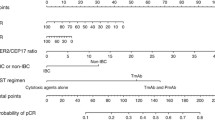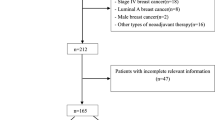Abstract
Purpose
The aim of this study was to assess the Institut Gustave Roussy/M.D. Anderson Cancer Center (IGR/MDACC) nomogram in predicting pathologic complete response (pCR) to preoperative chemotherapy in a cohort of human epidermal growth factor receptor 2 (HER2)-positive tumors treated with preoperative chemotherapy with trastuzumab. We then combine clinical and pathological variables associated with pCR into a new nomogram specific to HER2-positive tumors treated by preoperative chemotherapy with trastuzumab.
Patients and methods
Data from 270 patients with HER2-positive tumors treated with preoperative chemotherapy with trastuzumab at the Institut Curie and at the Georges François Leclerc Cancer Center were used to assess the IGR/MDACC nomogram and to subsequently develop a new nomogram for pCR based on multivariate logistic regression. Model performance was quantified in terms of calibration and discrimination. We studied the utility of the new nomogram using decision curve analysis.
Results
The IGR/MDACC nomogram was not accurate for the prediction of pCR in HER2-positive tumors treated by preoperative chemotherapy with trastuzumab, with poor discrimination (AUC = 0.54, 95% CI 0.51–0.58) and poor calibration (p = 0.01). After uni- and multivariate analysis, a new pCR nomogram was built based on T stage (TNM), hormone receptor status, and Ki67 (%). The model had good discrimination with an area under the curve (AUC) at 0.74 (95% CI 0.70–0.79) and adequate calibration (p = 0.93). By decision curve analysis, the model was shown to be relevant between thresholds of 0.3 and 0.7.
Conclusion
To the best of our knowledge, ours is the first nomogram to predict pCR in HER2-positive tumors treated by preoperative chemotherapy with trastuzumab. To ensure generalizability, this model needs to be externally validated.




Similar content being viewed by others
References
van der Hage JA, van de Velde CJ, Julien JP et al (2001) Preoperative chemotherapy in primary operable breast cancer: results from the European Organization for Research and Treatment of Cancer trial 10902. J Clin Oncol 19:4224–4237
Schwartz GF, Hortobagyi GN (2004) Proceedings of the consensus conference on neoadjuvant chemotherapy in carcinoma of the breast, April 26–28, 2003, Philadelphia, Pennsylvania. Cancer 100:2512–2532. doi:10.1002/cncr.20298
Sachelarie I, Grossbard ML, Chadha M et al (2006) Primary systemic therapy of breast cancer. Oncologist 11:574–589. doi:10.1634/theoncologist.11-6-574
Gown AM, Goldstein LC, Barry TS et al (2008) High concordance between immunohistochemistry and fluorescence in situ hybridization testing for HER2 status in breast cancer requires a normalized IHC scoring system. Mod Pathol 21:1271–1277. doi:10.1038/modpathol.2008.83
Rastogi P, Anderson SJ, Bear HD et al (2008) Preoperative chemotherapy: updates of national surgical adjuvant breast and bowel project protocols B-18 and B-27. J Clin Oncol 26:778–785. doi:10.1200/JCO.2007.15.0235
Guarneri V, Broglio K, Kau S-W et al (2006) Prognostic value of pathologic complete response after primary chemotherapy in relation to hormone receptor status and other factors. J Clin Oncol 24:1037–1044. doi:10.1200/JCO.2005.02.6914
von Minckwitz G, Untch M, Blohmer J-U et al (2012) Definition and impact of pathologic complete response on prognosis after neoadjuvant chemotherapy in various intrinsic breast cancer subtypes. J Clin Oncol 30:1796–1804. doi:10.1200/JCO.2011.38.8595
Cortazar P, Zhang L, Untch M et al (2014) Pathological complete response and long-term clinical benefit in breast cancer: the CTNeoBC pooled analysis. Lancet Lond Engl 384:164–172. doi:10.1016/S0140-6736(13)62422-8
Rouzier R, Pusztai L, Delaloge S et al (2005) Nomograms to predict pathologic complete response and metastasis-free survival after preoperative chemotherapy for breast cancer. J Clin Oncol 23:8331–8339. doi:10.1200/JCO.2005.01.2898
Buzdar AU, Ibrahim NK, Francis D et al (2005) Significantly higher pathologic complete remission rate after neoadjuvant therapy with trastuzumab, paclitaxel, and epirubicin chemotherapy: results of a randomized trial in human epidermal growth factor receptor 2-positive operable breast cancer. J Clin Oncol 23:3676–3685. doi:10.1200/JCO.2005.07.032
Gianni L, Eiermann W, Semiglazov V et al (2010) Neoadjuvant chemotherapy with trastuzumab followed by adjuvant trastuzumab versus neoadjuvant chemotherapy alone, in patients with HER2-positive locally advanced breast cancer (the NOAH trial): a randomised controlled superiority trial with a parallel HER2-negative cohort. Lancet 375:377–384. doi:10.1016/S0140-6736(09)61964-4
Frati A, Chereau E, Coutant C et al (2012) Comparison of two nomograms to predict pathologic complete responses to neoadjuvant chemotherapy for breast cancer: evidence that HER2-positive tumors need specific predictors. Breast Cancer Res Treat 132:601–607. doi:10.1007/s10549-011-1897-0
Sataloff DM, Mason BA, Prestipino AJ et al (1995) Pathologic response to induction chemotherapy in locally advanced carcinoma of the breast: a determinant of outcome. J Am Coll Surg 180:297–306
Chevallier B, Roche H, Olivier JP et al (1993) Inflammatory breast cancer. Pilot study of intensive induction chemotherapy (FEC-HD) results in a high histologic response rate. Am J Clin Oncol 16:223–228
R Core Team (2014). R: a language and environment for statistical computing. R Foundation for Statistical Computing, Vienna, Austria. http://www.R-project.org/. Frank E Harrell Jr., with contributions from Charles Dupont and many others. (2014). Hmisc: Harrell Miscellaneous
Whitcher B (2012) Waveslim: basic wavelet routines for one-, two- and three-dimensional signal processing. R package version 1.7.1. The Comprehensive R Archive Network (CRAN). http://cran.r-project.org/package=waveslim
R package version 1.7.5. http://cran.rproject.org/package=waveslim
Frank E Harrell Jr (2014). Rms: regression modeling strategies. R package version 4.2-1
Coutant C, Olivier C, Lambaudie E et al (2009) Comparison of models to predict nonsentinel lymph node status in breast cancer patients with metastatic sentinel lymph nodes: a prospective multicenter study. J Clin Oncol 27:2800–2808. doi:10.1200/JCO.2008.19.7418
Cox DR (1958) Two further applications of a model for binary regression. Biometrika 45:562–565
Vickers AJ, Elkin EB (2006) Decision curve analysis: a novel method for evaluating prediction models. Med Decis Mak 26:565–574. doi:10.1177/0272989X06295361
Kaufmann M, von Minckwitz G, Bear HD et al (2007) Recommendations from an international expert panel on the use of neoadjuvant (primary) systemic treatment of operable breast cancer: new perspectives 2006. Ann Oncol 18:1927–1934. doi:10.1093/annonc/mdm201
Kuerer HM, Newman LA, Smith TL et al (1999) Clinical course of breast cancer patients with complete pathologic primary tumor and axillary lymph node response to doxorubicin-based neoadjuvant chemotherapy. J Clin Oncol 17:460–469
Rouzier R, Extra J-M, Klijanienko J et al (2002) Incidence and prognostic significance of complete axillary downstaging after primary chemotherapy in breast cancer patients with T1 to T3 tumors and cytologically proven axillary metastatic lymph nodes. J Clin Oncol 20:1304–1310
Fisher B, Bryant J, Wolmark N et al (1998) Effect of preoperative chemotherapy on the outcome of women with operable breast cancer. J Clin Oncol 16:2672–2685
von Minckwitz G, Untch M, Nüesch E et al (2011) Impact of treatment characteristics on response of different breast cancer phenotypes: pooled analysis of the German neo-adjuvant chemotherapy trials. Breast Cancer Res Treat 125:145–156. doi:10.1007/s10549-010-1228-x
Untch M, Rezai M, Loibl S et al (2010) Neoadjuvant treatment with trastuzumab in HER2-positive breast cancer: results from the GeparQuattro study. J Clin Oncol 28:2024–2031. doi:10.1200/JCO.2009.23.8451
Coudert BP, Arnould L, Moreau L et al (2006) Pre-operative systemic (neo-adjuvant) therapy with trastuzumab and docetaxel for HER2-overexpressing stage II or III breast cancer: results of a multicenter phase II trial. Ann Oncol 17:409–414. doi:10.1093/annonc/mdj096
Guiu S, Gauthier M, Coudert B et al (2010) Pathological complete response and survival according to the level of HER-2 amplification after trastuzumab-based neoadjuvant therapy for breast cancer. Breast J Cancer 103:1335–1342. doi:10.1038/sj.bjc.6605939
R. Rouzier, C. Bonneau, C. Huchon, C. Coutant (2014) Pathologies mammaires et cancer du sein: modèles statistiques. In: Mises À Jour En Gynécologie Médicale. Diffusion Vigot-Paris, pp 423–434
Graesslin O, Abdulkarim BS, Coutant C et al (2010) Nomogram to predict subsequent brain metastasis in patients with metastatic breast cancer. J Clin Oncol 28:2032–2037. doi:10.1200/JCO.2009.24.6314
Jia Z, Lilly MB, Koziol JA et al (2014) Generation of “virtual” control groups for single arm prostate cancer adjuvant trials. PLoS ONE. doi:10.1371/journal.pone.0085010
Author information
Authors and Affiliations
Corresponding author
Ethics declarations
Conflict of interest
None of the authors has a financial interest or commercial associations to declare in relation to the content of this article.
Additional information
C. Coutant is a Co-senior author.
Electronic supplementary material
Below is the link to the electronic supplementary material.
Rights and permissions
About this article
Cite this article
Jankowski, C., Guiu, S., Cortet, M. et al. Predictive factors of pathologic complete response of HER2-positive breast cancer after preoperative chemotherapy with trastuzumab: development of a specific predictor and study of its utilities using decision curve analysis. Breast Cancer Res Treat 161, 73–81 (2017). https://doi.org/10.1007/s10549-016-4040-4
Received:
Accepted:
Published:
Issue Date:
DOI: https://doi.org/10.1007/s10549-016-4040-4




